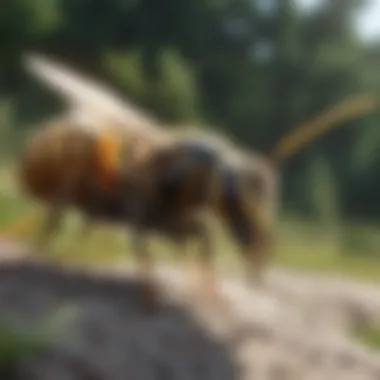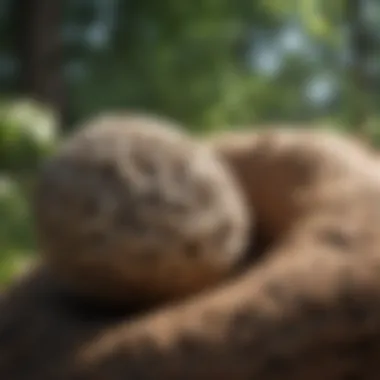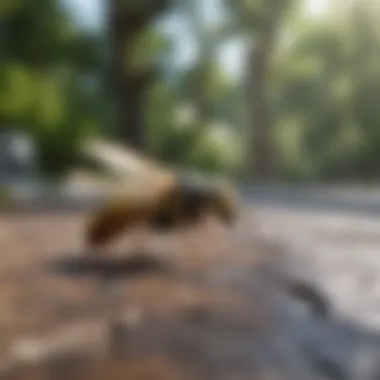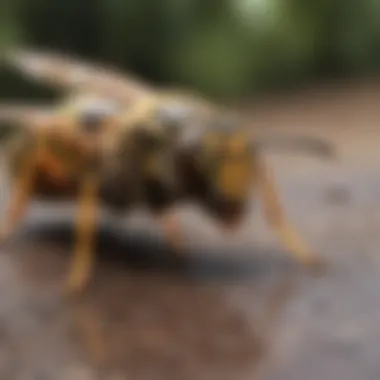Effective Strategies to Keep Wasps Away: Creating a Wasp-Free Environment


Animal Species Profile
Wasps are a diverse group of insects known for their striking appearance and distinctive coloring. With slender bodies, transparent wings, and characteristic yellow and black stripes, they are easily recognizable. These insects are commonly found in various habitats, including forests, gardens, and urban areas. Known for their aggressive behavior when threatened, wasps play a crucial role in their ecosystems by preying on other insects.
Natural Repellents
One effective method to deter wasps is by utilizing natural repellents. Substances such as peppermint oil, vinegar, and cinnamon are known to be effective at deterring these insects. By creating a spray using these repellents and applying it to potential entry points or nesting areas, individuals can discourage wasps from settling in their surroundings.
Preventative Measures
In addition to natural repellents, implementing preventative measures can help keep wasps at bay. Ensuring that food and garbage are properly sealed can minimize the attraction of wasps to a property. Removing standing water sources and sealing cracks and crevices where wasps might build nests are also crucial steps in preventing their presence.
Conclusion
Understanding Wasps
In the realm of pest control and wildlife management, understanding wasps plays a pivotal role in maintaining a harmonious living environment. By delving deep into the behavioral patterns, nesting habits, and distinct characteristics of wasps, individuals equip themselves with valuable insights essential for effective deterrence. Identification of various wasp species, such as social wasps, solitary wasps, and parasitic wasps, provides a nuanced understanding that aids in formulating targeted strategies aimed at deterring unwanted visitors.
Types of Wasps
Social Wasps
Social wasps, known for their communal living and hierarchical structures, present both challenges and opportunities in pest control. Their cohesive nature and organized colonies make them formidable yet intriguing subjects for study. Understanding the intricate social dynamics of these wasps sheds light on their behavior patterns and nesting preferences, offering crucial knowledge for devising preventive measures that disrupt their colonies effectively.
Solitary Wasps
Solitary wasps, in contrast to their social counterparts, lead independent lifestyles without forming structured colonies. Their solitary nature influences their nesting habits and foraging behavior, making them elusive yet significant in the ecosystem. By grasping the unique attributes of solitary wasps, individuals can implement strategies tailored to deter these solitary hunters while respecting their role in the natural balance of the environment.
Parasitic Wasps
Parasitic wasps, characterized by their parasitic breeding behavior, serve as natural biological controllers of pest populations. Their parasitoid larvae develop within other insects, offering an eco-friendly method of pest management. Understanding the symbiotic relationship between parasitic wasps and their hosts enlightens individuals on the intricate mechanisms of natural pest control, advocating for sustainable solutions that harness the power of these beneficial insects.
Behavior Patterns
Nesting Habits
The nesting habits of wasps provide crucial insights into their lifecycle and territorial behavior. Different species exhibit diverse nesting preferences, ranging from underground burrows to aerial hives. By studying these nesting habits, individuals can identify potential breeding grounds and implement preventive measures to deter nesting activities, thus reducing the likelihood of hostile encounters with wasps.


Feeding Preferences
Wasps exhibit varied feeding preferences, with social wasps often attracted to sweet substances while solitary species favor protein-rich food sources. Understanding the foraging patterns of wasps enables individuals to minimize attractants in their surroundings, decreasing the likelihood of wasp infestations. By adjusting food disposal practices and securing potential attractants, individuals can mitigate the risk of wasp intrusions effectively.
Response to Threats
The response of wasps to perceived threats is a critical aspect of their behavior that influences human-wasp interactions. While some species display aggressive defensive behaviors when threatened, others exhibit more passive responses. By acquainting oneself with the typical responses of different wasp species, individuals can adapt their behavior to avoid provoking defensive reactions and minimize the likelihood of stings. This nuanced understanding of wasp behavior significantly contributes to fostering peaceful coexistence with these pollinators and predators in the environment.
Factors Attracting Wasps
In the realm of deterring unwanted visitors, understanding the factors that attract wasps is paramount. These buzzing insects are drawn to specific elements in their environment, primarily revolving around food and nesting spots. By delving into the nuances of what appeals to wasps, individuals can strategically devise methods to keep these pests at bay. Factors attracting wasps act as the key determinants in the battle for a wasp-free living space.
Food Sources
Sugary Substances
Sugary substances serve as a significant lure for wasps, influencing their foraging habits and preferences. With a penchant for sweetness, these insects are irresistibly drawn to sugary nectars, fruits, and beverages. The strategic placement of attractants rich in sugar can inadvertently invite unwelcome wasp activity. Understanding the allure of sugar to wasps is crucial for implementing effective deterrent measures within the context of this article. While sugary substances may entice wasps, they also pose challenges when managing and repelling these buzzing pests.
Protein-Rich Foods
Conversely, protein-rich foods play a complementary role in attracting wasps, offering a vital food source in their diet. Insects, spiders, and even pet food high in protein content appeal to wasps seeking sources of nourishment. Incorporating insights into the significance of protein-rich foods in wasp behavior sheds light on the multifaceted strategies required to combat their presence effectively. Highlighting the nuances of their dietary preferences facilitates a comprehensive approach to mitigating the allure of protein-rich foods for these pesky insects.
Nesting Spots
Sheltered Areas
Sheltered areas provide ideal locations for wasps to establish their nests, offering protection from environmental elements and potential predators. Wall cavities, attics, and eaves serve as prime real estate for these insects to construct their hives discreetly. Recognizing the appeal of sheltered spots to wasps underscores the importance of addressing and securing such areas to prevent infestations. While sheltered locations guarantee safety for wasps, they pose challenges for individuals aiming to deter these unwanted visitors effectively.
Accessible Water Sources
Accessible water sources play a crucial role in supporting wasp colonies, ensuring hydration and survival for these buzzing insects. Ponds, bird baths, and leaky outdoor faucets serve as essential watering holes for wasps seeking moisture in their surroundings. Exploring the significance of water availability for wasps elucidates the necessity of managing water sources to discourage their presence. Understanding the vital role of accessible water sources in attracting wasps provides valuable insights for implementing strategies to counteract their nesting and foraging tendencies.
Natural Repellents
Natural repellents are a crucial aspect of this article, aimed at providing effective strategies to deter unwanted visitors like wasps around your living space. These repellents serve as a non-toxic and environmentally friendly solution to keep pests at bay. Their significance lies in offering a natural alternative to potentially harmful chemical deterrents, promoting a safer living environment for both humans and wildlife. By integrating natural repellents into your pest management routine, you not only protect your surroundings but also contribute to sustainable practices in pest control.
Essential Oils
Peppermint Oil


Peppermint oil plays a vital role in the overall goal of keeping wasps away from your vicinity. Its key characteristic lies in its strong scent, which is particularly unpleasant to wasps, deterring them from nesting or foraging around your home. This natural oil is a popular choice for its effectiveness in repelling various types of insects, making it a versatile option for combating multiple pests simultaneously. However, it is essential to note that while peppermint oil is highly effective in repelling wasps, its volatile nature can be overpowering to pets or individuals with sensitivities to strong odors.
Lemongrass Oil
When exploring natural repellents, lemongrass oil emerges as a standout option due to its citrusy aroma that repels insects, including wasps. The key characteristic of lemongrass oil lies in its ability to mimic natural citrus scents, creating a barrier that deters pests from entering your living space. This popular choice in pest control is favored for its pleasant fragrance, making it a refreshing addition to your household while effectively repelling unwanted visitors like wasps. However, while lemongrass oil is known for its effectiveness against pests, its application may require regular reapplication to maintain its potency against persistent insects.
Clove Oil
Including clove oil in your arsenal of natural repellents can significantly enhance your defense against pests like wasps. Clove oil's key characteristic is its strong, pungent scent, which disrupts the sensory receptors of insects, confusing and repelling them effectively. This natural oil is a beneficial choice for those seeking long-lasting protection against wasps, showcasing longevity in its efficacy as a barrier against unwanted visitors. However, it is essential to exercise caution with clove oil, as its potent odor may be too intense for individuals with a sensitive sense of smell.
Vegetation
Incorporating specific types of vegetation into your surroundings is a proactive measure to bolster your defense against wasps. These plant varieties not only serve as natural deterrents but also add aesthetic appeal to your living space. By strategically placing mint plants, basil, and lavender around your home, you create a natural barrier that repels wasps due to their strong scents and properties insects find unattractive. Mint plants are particularly effective in deterring insects with their refreshing aroma, while basil acts as a versatile herb that doubles as pest control. Lavender, known for its soothing fragrance, also plays a crucial role in repelling wasps and other pests from your vicinity. However, it is essential to research each plant's maintenance requirements and growth patterns to optimize their pest-repelling benefits.
Physical Deterrents
In the realm of deterring unwanted wasp visitors, the significance of physical deterrents cannot be overstated. These methods offer a tangible barrier against these pesky insects, adding an extra layer of defense to keep them at bay. Physical deterrents range from decoy nests to mesh screens, both serving as effective tools in warding off wasps from infesting your living space. By incorporating physical barriers, you not only discourage wasps from building nests but also protect your home environment from potential intrusions.
Decoy Nests
When it comes to decoy nests, their usage benefits lie in their remarkable ability to deceive and divert wasps away from your property. These imitation structures mimic real nests, tricking wasps into believing a territory is already claimed. As a result, they are deterred from establishing their nests nearby, reducing the likelihood of encountering these stinging insects within your vicinity. The key feature of decoy nests is their unmatched effectiveness in deterring wasps, making them a popular choice for individuals seeking a non-invasive and eco-friendly solution. While decoy nests are typically hassle-free to set up, it is essential to strategically place them in areas where wasps are prone to nest, maximizing their effectiveness in creating a wasp-free zone.
Placement Tips
Efficient placement of decoy nests is crucial in maximizing their deterrence effect against wasps. Strategic positioning in potential nesting spots around your property can significantly enhance their performance in discouraging wasps from settling in the area. By placing decoy nests near eaves, under rooflines, or in garden corners, you create an illusion of an occupied territory, deterring wasps from building nests in these locations. It is important to regularly inspect and relocate decoy nests to ensure their continued efficacy in deterring wasps and maintaining a wasp-free environment.
Mesh Screens
Integrating mesh screens into your home environment serves as a practical physical barrier against invading wasps. The installation process involves fitting mesh screens over openings like windows, vents, and chimneys to prevent the entry of these insects. The key characteristic of mesh screens is their ability to provide ventilation while effectively blocking access to wasps and other pests, ensuring a comfortable and pest-free indoor space. Mesh screens offer a durable and long-lasting solution, requiring minimal maintenance and providing year-round protection against unwanted insect intrusions.
Effectiveness
The effectiveness of mesh screens in keeping out wasps is unparalleled. By acting as a protective shield for your home, mesh screens offer peace of mind by creating a secure barrier that prevents wasps from entering your living spaces. Their durability and efficiency in blocking insect entry make them a popular choice for individuals seeking practical and long-term pest control solutions. While the installation process may be initially time-consuming, the benefits of having a wasp-proof home outweigh any minor inconveniences, ensuring a safe and enjoyable living environment free from unwanted wasp visitors.
Professional Solutions
By delving into the realm of Professional Solutions for keeping wasps at bay, we encounter a pivotal aspect in the quest for a wasp-free environment. Professional Solutions offer a systematic and strategic approach to addressing wasp infestations effectively. These solutions encompass a range of specialized services and industry expertise that can significantly enhance property protection and human safety. When considering Professional Solutions, one must weigh several essential elements such as the expertise of pest control professionals, the tailored strategies employed to tackle unique infestation scenarios, and the use of environmentally friendly practices. Embracing Professional Solutions ensures a comprehensive and lasting resolution to wasp-related challenges.
Pest Control Services


In the context of wasp management, Pest Control Services emerge as a crucial component of Professional Solutions. The Benefits stemming from professional pest control interventions are multifaceted. They encompass the proficient identification of wasp species, the tailored application of treatment methods, the effective removal of nests, and ongoing monitoring to prevent re-infestation. Through Pest Control Services, property owners can experience relief from the dangers and nuisances posed by wasps. However, it is essential to consider certain factors known as Considerations. These include the potential use of chemical agents, the necessity for repeated treatments in severe infestations, and the financial investment required for professional services. Balanced consideration of both Benefits and Considerations is indispensable for making informed decisions regarding Pest Control Services.
Benefits
The Benefits of Pest Control Services lie in their ability to provide targeted solutions that directly address wasp-related challenges. Professional pest control experts possess the knowledge and tools necessary to identify, assess, and mitigate wasp threats effectively. By entrusting the management of wasp infestations to skilled professionals, individuals can benefit from a swift and comprehensive resolution to their pest issues. Additionally, Pest Control Services offer a layer of safety and peace of mind, knowing that the eradication process is handled expertly and in alignment with industry standards.
Considerations
Despite the numerous benefits of Pest Control Services, certain Considerations warrant attention. The application of chemical treatments, while effective, may raise concerns about environmental impact and potential health risks. Furthermore, recurring treatments may be necessary in cases of persistent infestations, leading to additional costs. Moreover, the financial investment required for Pest Control Services should be weighed against the benefits derived from professional intervention. Balancing the advantages and disadvantages of Pest Control Services is crucial in maximizing the efficacy of wasp management programs.
Traps and Baits
Another facet of Professional Solutions involves the deployment of Traps and Baits to lure and capture wasps effectively. Various types of traps are available, each tailored to attract specific wasp species based on their feeding preferences and pheromones. Traps serve as a non-invasive method of capturing wasps without resorting to harmful chemicals. Their versatile design allows for placement in strategic locations to intercept wasp activity. However, the Effectiveness of traps and baits is contingent upon factors such as trap placement, attractants used, and the timing of deployment. When implemented correctly, traps and baits can significantly reduce wasp populations and mitigate the risks associated with their presence.
Types
Diving into the realm of trap Types, we encounter a diverse array of options designed to target different species of wasps effectively. From bottle traps to hanging traps, each type offers a unique approach to attracting and entrapping wasps. The selection of trap type is influenced by factors such as the predominant wasp species in the area, the desired trapping capacity, and the ease of maintenance. By choosing the appropriate trap type based on specific infestation dynamics, property owners can enhance the success rate of their trapping efforts.
Effectiveness
Effectiveness stands as a pivotal aspect of trap and bait utilization in wasp control strategies. The key characteristic of trap Effectiveness lies in its ability to capture targeted wasp species consistently. By leveraging attractants that mimic natural prey sources or nesting materials, traps and baits can entice wasps to their confinement effectively. This methodical approach to pest management ensures a proactive stance against invasive wasp populations. However, the Effectiveness of traps is influenced by external factors such as weather conditions, competing food sources, and proximity to nesting sites. Regular monitoring and adjustment of trap placements are essential to maximize their Effectiveness in controlling wasp populations.
Preventative Measures
In this section of our comprehensive guide on keeping wasps away, we delve into the crucial topic of Preventative Measures. Preventative Measures are essential in maintaining a wasp-free environment, as they help deter unwanted visitors and ensure the safety of your living space. By implementing Preventative Measures, homeowners can proactively reduce the risk of wasp infestations and related nuisances. One of the key benefits of integrating Preventative Measures is the long-term effectiveness in discouraging wasps from nesting or foraging around your property. Moreover, considering the potential allergic reactions and stings associated with wasps, Preventative Measures play a vital role in safeguarding the well-being of individuals and pets.
Regular Cleaning
Outdoor Spaces
One fundamental aspect of Preventative Measures is the meticulous upkeep of Outdoor Spaces. Outdoor Spaces, which include gardens, patios, and yard areas, contribute significantly to the overall attractiveness of a property. By maintaining cleanliness in Outdoor Spaces, homeowners can eliminate potential nesting sites and food sources that may attract wasps. Regularly removing clutter, fallen leaves, and debris from Outdoor Spaces is pivotal in reducing the likelihood of wasps establishing colonies near your home. The orderly and tidy Outdoor Spaces not only enhance the aesthetic appeal of your property but also act as a deterrent for wasps seeking suitable harborage locations. Although the meticulous maintenance of Outdoor Spaces requires time and effort, the benefits of a well-kept environment far outweigh the inconveniences.
Food Disposal
Effective Food Disposal practices are another essential component of Preventative Measures against wasps. Properly managing food waste and disposing of it promptly can prevent the accumulation of organic matter that may attract foraging wasps. It is imperative to securely seal garbage bins and compost containers to minimize odors that could lure these insects. Utilizing tightly sealed bins, composting in enclosed containers, and avoiding leaving food residues outdoors can significantly decrease the chances of encountering wasps scavenging for food near your home. Additionally, adhering to a disciplined routine of food disposal not only reduces the risk of attracting wasps but also enhances overall sanitation practices within the household.
Sealing Entry Points
Gaps and Cracks
Addressing Gaps and Cracks in the structural integrity of your home is paramount in preventing wasps from gaining entry. Gaps and Cracks in walls, windows, doors, and other openings serve as potential entry points for pests, including wasps. By identifying and sealing these vulnerable areas, homeowners can fortify their property against unwanted intrusions. Ensuring that gaps and cracks are properly sealed with durable materials such as silicone sealant or weatherstripping can effectively block access for wandering wasps. The meticulous sealing of these entry points not only hinders the ingress of pests but also aids in regulating indoor temperature and enhancing energy efficiency.
Utility Openings
Another critical aspect of Sealing Entry Points involves securing Utility Openings throughout the premises. Utility Openings, such as vents, pipes, and electrical conduits, often provide entry for insects seeking refuge or nesting sites. By installing fine mesh screens or using specialized covers on these openings, homeowners can prevent wasps from infiltrating their homes via utility entryways. Maintaining the integrity of Utility Openings by regularly inspecting and repairing any damages can significantly reduce the chances of encountering wasps indoors. By fortifying these vulnerable points with protective barriers, homeowners can create an exclusionary barrier that deters pests and promotes a harmonious living environment.







